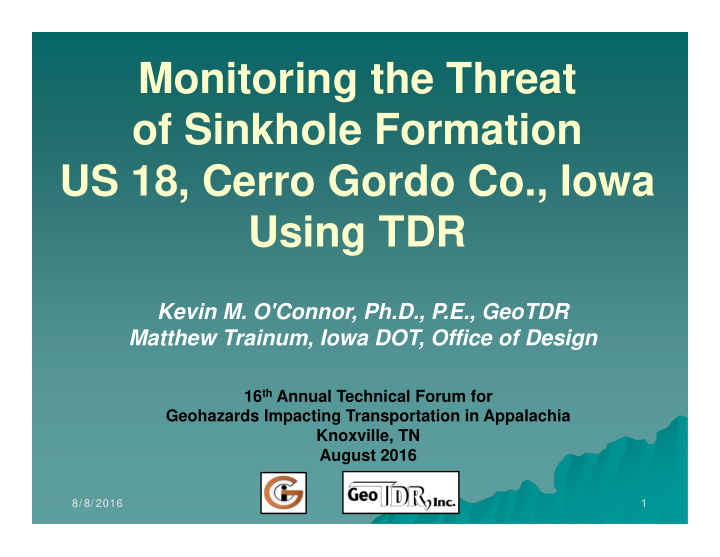



Monitoring the Threat of Sinkhole Formation US 18, Cerro Gordo Co., Iowa Using TDR Kevin M. O'Connor, Ph.D., P.E., GeoTDR Matthew Trainum, Iowa DOT, Office of Design 16 th Annual Technical Forum for Geohazards Impacting Transportation in Appalachia Knoxville, TN August 2016 8/ 8/ 2016 1
Site Location and Conditions 8/ 8/ 2016 2
3 Sinkholes in Iowa 8/ 8/ 2016
4 8/ 8/ 2016
5 2004 8/ 8/ 2016
6 EB inside 8/ 8/ 2016
7 EB outside 8/ 8/ 2016
8 EB outside ditch 8/ 8/ 2016
2004 Investigation A geophysical investigation, to determine the cause of the problem and propose options for remediation, included a Ground Penetrating Radar Survey, a Resistivity Survey, and a Soil Survey (drilling program). No voids were identified beneath or within a couple meters of the pavement. 8/ 8/ 2016 9
10 2005 2004 8/ 8/ 2016
11 Outside ROW - South 8/ 8/ 2016
12 2008 2005 2004 8/ 8/ 2016
Decision + In 2009, a project was designed for letting that would install a double reinforced inlay, including shoulders, for the designated area of concern on US 18 in Cerro Gordo County, Iowa. In addition to the inlay, the installation of a Time Domain Reflectometry System (TDR) was chosen as a real-time monitoring device for the formation of voids/ sinkholes under the roadway. 8/ 8/ 2016 13
14 8/ 8/ 2016
15 8/ 8/ 2016
16 8/ 8/ 2016
17 8/ 8/ 2016
18 8/ 8/ 2016
19 8/ 8/ 2016
TDR Principle 8/ 8/ 2016 20
Cables can be grouted into boreholes or trenches to monitor deformation TDR Cable Tester Expansive Cement Grout Crimp In Cable 8/ 8/ 2016 21
Activity up to Present Time 8/ 8/ 2016 22
crimps abrasion Cable shear would produce same reflection as a crimp Ground movement would fracture grout then cable deformation occurs 8/ 8/ 2016 23
Consistent and persistent response on all eight cables Abrasion not Shear Deformation of Cables 8/ 8/ 2016 24
Limited Correlation Among TDR, Geophysics, Drilling, and Sinkholes STA 248+75 8/ 8/ 2016 25
Eastbound STA 248+75 26 8/ 8/ 2016
In Nov 2011 and Jan 2012 exploratory drilling and geophysics did not find voids below pavement 8/ 8/ 2016 27
TIMING – new activity develops between September and March 2011, 2012, 2013, 2014, 2015, 2016 8/ 8/ 2016 28
Possible Causes Ground Movement – Little or no indication of shear – Movement must cause abrasion Soil or Grout Shrinkage – Requires sufficient shrinkage to cause abrasion Frost Heave – Timing of TDR activity does not entirely coincide with period when frost is deepest Gnawing Animals – IS THIS EVEN A POSSIBILTY?? 8/ 8/ 2016 29
30 8/ 8/ 2016
31 8/ 8/ 2016
32 8/ 8/ 2016
33 8/ 8/ 2016
34 8/ 8/ 2016
35 Additional Evidence of Burrowing 8/ 8/ 2016
36 8/ 8/ 2016
37 STA 252+02 Recent TDR Activity 8/ 8/ 2016
38 STA 252+02 8/ 8/ 2016
39 8/ 8/ 2016
40 0.003 mm/day 8/ 8/ 2016
Current Status The persistence and consistency indicate valid data The cause of cable abrasion is currently indeterminate Even with this uncertainty, can still detect cable deformation… so monitoring continues 8/ 8/ 2016 41
Questions for You The cause of cable abrasion is currently indeterminate Has anyone seen precursor burrowing by animals in karst areas? Can you suggest other causes? Why limited to Sept-March? 8/ 8/ 2016 42
Real Time Monitoring with Time Domain Reflectometry (TDR) Kevin M. O'Connor , Ph.D ., P.E. GeoTDR, Inc. Westerville, Ohio www.geotdr.com 8/ 8/ 2016 43
Recommend
More recommend